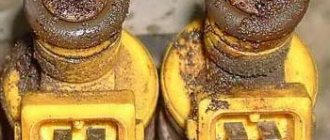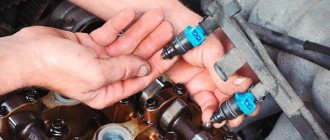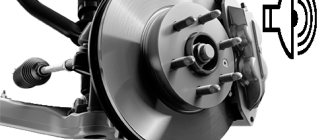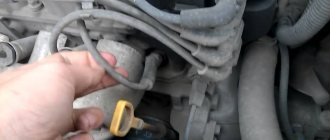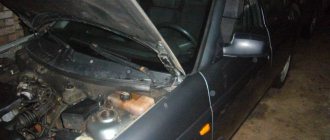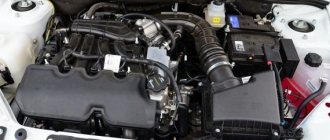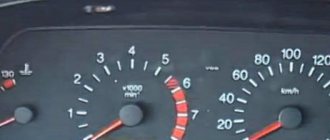There are many reasons for this. But among them we can distinguish those that occur in almost 90% of cases.
First of all, it is necessary to exclude the influence of low temperatures. In cold weather, the car may not start due to insufficient battery power, as well as due to the use of summer oil, which becomes very thick (these are two main reasons, but there may be others: for example, bad spark plugs or a clogged fuel pump).
Installing an automatic engine warm-up system can help here. If problems with operation occur even at positive temperatures, then it is necessary to continue troubleshooting.
- Quite often, poor car starting is due to low fuel quality. In this case, the injectors and fuel filters may become clogged.
- The air filter may also become dirty. Replacing it is quite simple and completely solves the problem.
- On diesel engines, poor starting can be caused by incorrectly selected fuel. Such motors require a seasonal change in types of diesel fuel (“summer”, as well as “winter” or “arctic” - for especially cold regions).
- Low compression in the combustion chamber. A decrease in pressure can occur due to engine wear (during its operation, the gaps are closed by an oil film, while when they cool, they reappear), as well as due to incorrect installation of the timing belt.
- Another reason why an injection engine has difficulty starting when cold is the failure of the sensors (DPRV, DPS, DMRV).
- It was already written above that problems with starting in winter can arise due to bad spark plugs or a clogged fuel pump. It is worth noting that these problems can also arise at positive temperatures.
- Sometimes poor starting is caused by a lack or, on the contrary, an excess of fuel when supplied. On injection engines, spark plugs may flood in the winter (this problem usually occurs in used cars). In this case, you need to unscrew them and dry them.
- A fairly common reason why a cold engine does not start well is contamination of the throttle valve. In this case, it does not open completely, which is why the motor does not work properly.
- There is a fault in the electrical circuit. If the battery has a charge, but there is no spark at the spark plugs, you need to make sure that the high-voltage wires are intact, as well as the functionality of the ignition coil (checked with a multimeter). True, with such a breakdown, starting problems will arise not only on a cold engine.
- Sometimes the cause of poor starting is a dirty idle air valve. After cleaning it, problems with engine operation should disappear.
Important! If, when you try to start the engine, smoke comes out of the exhaust pipe and the car does not start, it means that fuel is being supplied, but it is not ignited.
Identifying and eliminating engine starting problems
In most cases, problems can be identified and fixed without much difficulty. So, a sign of clogged fuel filters will be difficulties starting the engine (it may stall at idle), a decrease in power, and also the car jerking during inclines.
It is worth noting that such “symptoms” can also be the result of other faults, such as wiring problems or faulty spark plugs. In this case, it is necessary to urgently replace the filters. If this is not done in time, the motor may fail.
Fuel supply can be checked by unscrewing the spark plugs. If they are filled with gasoline, or, on the contrary, are completely dry, then it is necessary to check the sensors or adjust the carburetor.
Another problem, a sign of which may be that the engine does not start when cold, is clogged injectors. In this case, the car loses dynamics when accelerating sharply, twitches and reacts poorly to pressing the gas pedal. In addition, muffled high-frequency noises may be heard coming from the cylinder block.
If the injectors are indeed coated with deposits, they need to be cleaned. You can do this yourself. There are several main ways to restore this part:
- The first cleaning method is rather preventive. It consists of adding special additives to the fuel that help get rid of deposits on the injector. However, many motorists try to use this method as little as possible: it is believed that additives can further worsen engine performance.
- Some experts recommend periodically turning the engine up to high speeds. After several kilometers at a speed of 100-110 km/h, engine performance should improve somewhat.
- If the injectors are seriously dirty, you will have to clean them manually. To do this, you need to disassemble the injector. After this, the parts are washed with high-quality fuel without impurities or kerosene and blown with compressed air.
- There are two more ways to clean injectors. They guarantee almost 100% results, but to implement them you need to use professional equipment and have certain skills. Therefore, it is better to contact a service center here. In the first case, the parts are exposed to ultrasound, which destroys all plaque. In the second, a special liquid and a device are used that is connected to the fuel receiver. After the engine has been idling for some time, the injector will be cleaned.
Important! You should not take action without making sure that a specific node is indeed the cause of the poor startup. This is especially true for complex work, the incorrect execution of which can lead to even more serious damage. If in doubt, it is better to turn to professionals.
In conclusion, it is worth adding that it is better to look for the reasons for poor starting of a cold engine as they become more complex. So, you should not check the timing belt or engine compression without making sure there is fuel in the gas tank and a charge in the battery.
By methodically considering all possible fault options, you can get to the true cause of a poor start, and, in most cases, fix it yourself.
Why does my car start poorly when cold? List of reasons
Why is my car hard to start when cold? This question can often arise among drivers and car owners who just recently drove the car, and everything was fine, it sat, cooled down and does not start or starts with great difficulty.
It should be noted that there are no problems when it’s hot. Many modern cars have heating systems installed before starting, however, this does not always save.
When such problems arise, and often this happens in the morning, in front of the car with the hood open, fuss begins to warm it up and subsequent frantic attempts to start it. But, probably, every person who has a car wants to get into it, start it and drive, and not wake up with thoughts of whether it will start or not. In this article we will look into what causes the power unit to start poorly when cold.
Why is it difficult to start a car when it’s cold? It is impossible to answer this question unambiguously and accurately. The following can be taken as the main axioms of the reasons: there is nothing to ignite in the combustion chamber and there is nothing to ignite in the combustion chamber.
Of these two principles, all the rest will be only causes of a given effect. So, now let's look at each axiom separately. The concept of nothing to ignite means not only the absence of fuel, but also poor quality of its supply to the combustion chamber: too little fuel and too much fuel.
An indicator of the first reason can be a candle. We unscrew it (after turning it with the starter) from the engine and look at it: if it is flooded with gasoline, it means it is overflowing and we look further point by point, if it is dry, fuel is not delivered and again we look for the reason point by point. Also check the candle by smell - if it doesn’t smell like gasoline at all, then the cause has been found.
Let's move on to the second reason. If we checked the fuel supply and everything is as it should be, we look for the cause in the ignition device:
- First of all, we check the battery. It may be too discharged, and the starter barely turns or at different speeds;
- Malfunctions in the ignition distributor. At the same time, the machine does not try to “grab”, so to speak;
- Fracture or piercing of a high-voltage wire. In a shaded area when starting the engine, you can see a glow on these wires;
- The ignition coil is faulty. You can check with a multimeter (if there is only one ignition coil);
- The simplest thing is that the spark plugs have failed.
Naturally, when first considering the problem of cold starting, you should not look for the problem in the fuel pump, disassemble the injector, go to the timing belt, or open the cylinder block. As a rule, such reasons are rare, but they do occur, so you still need to start with the simpler ones and gradually move closer to the more complex ones.
In the article we tried to answer the question as fully as possible: why is it difficult for a car to start when it’s cold? If these problems occur, try leaving the car in cold air less often or warm it up over time.
Today you can find special devices that will maintain the engine temperature constant or turn on and warm it up at certain intervals. For example, the Tomahawk copes with this task.
For what reasons can a car have difficulty starting when cold?
It happens that you urgently need to go to work, but the car, after sitting all night, will not start. So why does a vehicle that is in good working order after the last trip suddenly refuse to start? Or does it stall as soon as you crank the engine? Let's look at the reasons why a car may have difficulty starting when cold.
First of all, it is necessary to make a reservation - your car starts perfectly if the engine has not had time to cool down, but in the case when the vehicle sits until the engine has completely cooled down, starting is difficult or completely impossible. In such a situation, even modern systems for heating and maintaining engine temperature do not always help. Let us consider in more detail the situation when a cold engine does not start well.
Voltage sag
With the arrival of cold weather, the degree of self-discharge of the battery increases. A decrease in electrolyte density, sulfitation of plates and a short circuit between banks lead to a decrease in voltage in the on-board network. The progression of non-negotiable processes is a consequence of the exhaustion of the battery life or non-compliance with recommendations for operation and maintenance.
The starter is one of the most powerful consumers in a passenger car. At the time of startup, the current consumption can reach 400-450 A.
As the starting speed decreases, fuel combustion worsens, making a cold engine difficult to start. Drawdown also leads to a deterioration in the quality of the spark discharge on the spark plugs.
Causes of problematic startup
Causes of problematic starting of a cold engine
When determining the reasons why the car has trouble starting when cold, you will first need to make sure that the battery is not discharged and that the starter is in good working order (the engine turns smoothly and smoothly). A separate reason that requires exclusion is refueling a car with low-grade gasoline. The quality of the fuel being poured greatly influences the trouble-free starting of the vehicle. If the battery is not discharged, the starter is working properly and the fuel is of appropriate quality, you can suspect the following main problems if it is difficult to start the vehicle when it is cold:
- the fuel pump has failed;
- the fuel filter is clogged (due to low-quality fuel);
- injectors are clogged (due to fuel);
- The fuel pressure regulator has malfunctioned;
- air leak;
- the spark plugs, ignition coils, and high-voltage wires have exhausted their service life;
- clogged idle valve;
- The mass air flow sensor is faulty;
- temperature sensor malfunction;
- valve clearance violations;
- the oil is out of season.
This is interesting: How to adjust the carburetor on a trimmer
Having considered possible malfunctions due to which the car may not start well when cold, let’s move on to studying ways to detect and eliminate them.
Features of starting a diesel engine
Unlike a gasoline internal combustion engine, where the mixture is ignited by a spark, the fuel in a diesel engine is ignited by contact with heated air. To raise the temperature in the combustion chamber, the air must be compressed many times. That is why the actual compression of an average gasoline engine is 10-12 Atm, while in a diesel internal combustion engine this figure can reach 20-25 Atm. High demands on the preparation of the air-fuel mixture result in a large load on the starter.
Therefore, in a diesel engine, the requirements for the condition of the battery, the serviceability of the starter and the supply voltage in the circuit are much higher than for their gasoline counterparts.
The common rail injection system control unit blocks the control impulse for opening the fuel injectors if sufficient pressure does not develop in the fuel rail when the starter is cranked.
The insidiousness of such a control algorithm is that it can be difficult to determine by ear the missing 50-70 rpm and the associated lack of pressure in the ramp. It may seem that the starter rotates the engine quite vigorously, and therefore there are no complaints about the battery and the starter. To understand why a diesel car has difficulty starting when cold, we recommend using diagnostic equipment to monitor the following parameters at the time of start-up:
- actual voltage of the on-board network;
- fuel pressure in the ramp, pumping section;
- the number of engine revolutions at the moment the starter cranks;
- temperature of the coolant, outside air. The temperature parameter is necessary to increase the fuel portion (richen the mixture) during a cold start.
Troubleshooting and troubleshooting in different types of engines
A problem with spark plugs is a common cause of poor starting in a cold engine.
Different types of engines have their own trouble indicators. It happens that a gasoline engine has difficulty starting when cold, and one of the main ways to find out the cause of the problem is the spark plug. It may also be the reason why diesel engines have trouble starting in cold weather. Indications for checking spark plugs, testing the battery, checking explosive wires and the ignition coil are jumping speed, engine tripping and poor cold starting, but only when the problems go away after warming up.
If the spark plug is dry, the problem is in the fuel line, as it indicates that fuel is not being supplied to the system.
Let's examine the spark plugs. Having unscrewed the spark plug, we carefully examine it. If the spark plug is wet, this indicates an overflow of fuel. Then suspicions fall on an electrical failure. We check the high-voltage wires, then we diagnose the ignition coil and battery.
We check the performance of the spark plug itself: serviceable spark plugs have a good spark. If the spark plugs fail, it is better to replace them with new ones. High-voltage wires can be checked in a dark room - if a glow is visible in the dark, the wires have been broken and they also need to be replaced.
Diagnosis of the causes of difficult starting
When a car has difficulty starting from a cold engine to a cold one, there may be different reasons. If the indicator is a dry spark plug, this is a sign of a problem with fuel supply. This can happen due to clogged filters - fine and coarse cleaning. If the engine still has difficulty starting when cold, pay attention to the injectors.
A faulty injector may be indicated by a spark plug flooded with gasoline after an unsuccessful start.
Another characteristic feature of this malfunction is poor starting in hot weather with a warm engine, and in winter problems arise with starting a vehicle that has already cooled down. You can check whether the problem is correctly detected by reducing the pressure in the fuel system before stopping the engine for an extended period of time. The injectors may be incorrectly adjusted or leaking. Additionally, we examine the fuel system for leaks, kinks or creases. Due to damage, air can leak inside and prevent the engine from starting when cold. It happens that the starter is fine, the spark plugs and wires are normal, but the engine does not start. Then you need to look for the cause in the sensor that regulates the coolant or check the pressure in the fuel system.
Carburetor
The main reasons for poor starting of a carburetor engine after cooling to a cold state is the failure of the ignition distributor. Determined by cranking the starter - it turns out that the engine does not “grab.” The next reason is the ignition coil, the serviceability of which is checked with a multimeter. The switch, distributor, or carburetor settings may also be faulty. If a car with a carburetor is very difficult to start when cold, or after that it starts and stalls, this indicates a breakdown of the diaphragm in the starting device.
Injector and starting problems
Problems starting a cold injection engine
When a car cannot start when cold (cold engine), the injector installed on it requires a special approach to finding the reasons. In this case, first of all, you can turn your attention to the sensors. As a result of their malfunction, incorrect signals are sent to the electronic control unit. The functionality of the following sensors should be checked:
- throttle valve;
- fuel consumption;
- coolant temperature;
- mass air flow;
- The operation of the fuel regulator is often disrupted.
On cars with a mechanical injector, the root cause of poor starting is the starting injector. Probably, after these actions, the question is, “Why does my car have trouble starting in the morning when it’s cold with an injector inside?” will leave the owner of the car.
The injector does not start well when cold
The first thing you should pay attention to when an injection car is performing poorly is the sensors. Failure of some of them leads to difficulty starting the engine, since incorrect signals are sent to the ECU. It is usually difficult to start when cold due to :
- coolant temperature sensor, DTOZh informs the control unit about the state of the coolant, these indicators affect engine starting (unlike a carburetor car), adjusting the composition of the working mixture;
- throttle sensor;
- fuel consumption sensor;
- Mass air flow sensor (or MAP, intake manifold pressure sensor).
If everything is in order with the sensors, first of all you need to pay attention to the following components:
- Often there is a problem with cold starting due to the fault of the fuel pressure regulator . Well, of course, whether it’s an injector or a carburetor, when a cold car doesn’t start well, if it stalls, the speed jumps, but after warming up everything is fine, then it’s imperative to check the condition of the spark plugs, and use a multimeter to check the coils and explosive wires.
- Leaking injectors cause a lot of trouble when it’s hot outside, the car will have difficulty starting on a hot engine, and in the cold season a dripping injector will cause difficulty starting in the morning . To test this theory, it is enough to simply release the pressure from the vehicle in the evening so that there is nothing to drip, and look at the result in the morning.
- We cannot exclude such a banal problem as air leaks in the power system - it complicates starting a cold engine. Also pay attention to the fuel poured into the tank, since its quality greatly affects engine starting.
On cars such as the Audi 80 (with a mechanical injector), we first check the starting injector.
General advice: if the starter turns normally, the spark plugs and wires are in order, then the search for the reason that it is difficult to start on a cold injector should begin by checking the coolant sensor and checking the pressure in the fuel system (how much it holds and for how long), since these are two the most common problems.
Diesel engines
In a gasoline engine, troubleshooting should begin with the spark plugs, and when a diesel engine has trouble starting when cold, the reasons should begin with loss of compression. A loss of compression can be assumed when the car is started after acceleration by hand, and after that, blue smoke is observed from the exhaust pipe for some time. Low compression can occur if the valve clearances are set incorrectly. Another reason is that the timing belt is not installed correctly. If the compression is normal, you should pay more attention to the choice of high-quality fuel (its suitability for the season), fuel supply and the next reason - glow plugs.
Starting in cold weather
Tips for winter starting the engine
If your car has trouble starting in cold weather, following simple rules can correct this situation.
- Try to keep your fuel tank full to help prevent condensation from forming and mixing water with fuel. This way the quality of the fuel will not deteriorate.
A car that runs on gas and cannot start well when cold - never start it without switching to gasoline! Is it dangerous!
- Before starting the engine, when it is frosty outside, it is advisable to turn on the high beams and turn them off after a couple of seconds. This procedure will help partially restore the battery capacity and eliminate poor starting in cold weather.
- Before starting a car with a carburetor, you need to pump up the fuel a little (be careful not to fill the spark plugs!).
- After turning the key in the ignition, if the car has an injector, do not rush to start the engine. It is worth waiting a while for the required pressure in the fuel system to rise.
How to start a car in cold weather
How can I start my engine in cold weather?
There's little you can do to immediately reverse the effects of cold weather on an already icy engine. But here are a few things you can do that can help start your engine in the winter.
When you try to start the engine, it may not turn over (the engine does not move at all). Instead, you may hear a series of clicking sounds. This could be a sign of a dead battery, loose or corroded battery cables, or some other problem with the starting system.
- Check the battery
- Turn on the headlights. If they are bright, almost normal, you still have battery power; otherwise, the battery power may be low. Continue with the next steps.
- Turn the ignition key to the on position for approximately 8 seconds, but do not start the engine. Repeat the process once or twice and try starting the engine. Fuel pressure may need a little help.
- If nothing happens, look under the hood. If you see signs of corrosion on one or both terminals on the battery or ground, or they are slightly loose when you turn them, this could be your problem. Remove corrosion from cables and terminals or tighten cables with a wrench.
- If everything looks normal, the battery may be dead. For such cases, you can use a car jump starter.
- As a battery ages, its chances of successfully handling cold temperatures also decrease. The average battery life is four to five years, although some manufacturers recommend replacing the battery every three years. If your battery is reaching the end of its life, you can install a new battery now.
- Check battery connections
In the summer, you can avoid corrosion between the battery terminals and the wire terminals, but not in the fall and winter, when there is high humidity in the air. Corrosion acts as electrical resistance, which ultimately greatly reduces the starting current, causing the starter to turn poorly and the car simply not to start.
Sometimes corrosion is hidden between the inside of the terminal and the battery terminal. If you haven't checked your terminals recently, now is the time:
- Disconnect the battery terminals (negative first, then positive) using a wrench.
- If necessary, make a solution of a glass of warm water and a tablespoon of baking soda in a disposable cup. Mix the solution thoroughly.
- Soak the battery terminals in the solution for a few seconds and use a soft brush to remove any corrosion from the terminals. If necessary, use a wire brush to remove corrosion.
- Use a soft brush to also clean the battery terminals. Wipe the terminal holes with a clean rag.
- Also, if necessary, clean the top of the battery. Using a solution of warm water and baking soda mixture, apply the solution with a soft brush and wipe with a clean rag. Do not allow the solution to seep under the battery caps.
- Check battery electrolyte
- On batteries with removable caps, wipe the top of the battery with a shop rag to prevent debris from getting into the battery cells before removing the caps.
- Remove the caps using a flathead screwdriver and check the electrolyte level.
- The electrolyte should reach the bottom of the filling rings. If not, add the required amount of distilled water to each cell.
A worn starter may not work at low temperatures.
- Check battery and solenoid for voltage
Sometimes the problem is that either your battery or a connection in the starting system is preventing the required current from getting to the starter. The car has trouble starting when cold when you turn the key to start the engine.
- Make sure your battery is 12.4V or more. Measure the battery voltage at the battery terminals using a voltmeter. If you get less than 12.4 volts, you need to charge the battery.
- At the starter solenoid (selector relay), connect the red voltmeter lead to the S (start +) terminal and the black meter lead to the battery ground (-). You must get at least 12 volts when the ignition key is turned to start the engine; otherwise, there is a loose or corroded wire in the ignition path of the starting circuit.
- If everything looks normal at this point, it is recommended to run a voltage drop test on the system. Testing the voltage drop in the starter system will be a more accurate and faster way to locate the faulty circuit section if you suspect a circuit problem in the starting system. Be sure to also perform a voltage drop test on the ground side of the circuit. Many problems with the circuit are due to bad contacts.
If necessary, check the charging system.
Reasons why the car doesn't start well when cold
On automobile forums you can often come across the question: why does the engine start poorly when cold? It happens that a person has driven a car for some time, parked it, the engine has cooled down, and when he needs to drive again, it either does not start at all or starts, but with great difficulty. Moreover, if the engine has not yet completely cooled down, then it starts up calmly. Why is this happening?
There are two basic reasons - either it is 1) a problem in the fuel supply, or 2) a problem in the ignition system.
The following malfunctions lead to incorrect fuel supply:
1. Poor quality fuel. 2. The injectors are clogged. 3. The coarse filter is clogged. 4. The fine fuel filter is clogged. 5. The throttle valve is clogged (cleaning the throttle valve). 6. The idle jet is clogged. 7. Insufficient pressure in the fuel pump. 8. Fuel pressure is not adjusted correctly. 9. The air filter is clogged. 10. The outside temperature is too low to start the engine.
Now you need to determine whether, in your case, there is a problem with the fuel supply - the spark plug will tell you about this. You need to turn the starter, unscrew the spark plug and inspect it: if it is filled with gasoline, it means that too much fuel is entering the combustion chamber; if it is completely dry, it means that not enough fuel is entering.
Next, refer to the list of faults for fuel supply problems listed above and identify this fault.
If the engine doesn’t start well when cold, but you still haven’t found any problems with the fuel supply, then the whole point is in the second reason: there is a problem in the ignition system.
The following reasons lead to malfunctions in the ignition system:
1. The spark plugs are worn out (how to check the spark plugs). 2. The battery is discharged, and the starter turns very weakly, at an uneven speed. 3. The ignition distributor is faulty. 4. The high-voltage wire is broken or punctured (in a dark place, when starting the engine, a glow will be noticeable on this wire). 5. The ignition coil is faulty (if there is only one, you can check it with a multimeter).
If the compression pressure in the combustion chamber has sharply decreased, this will inevitably lead to problems with fuel ignition.
Reasons for decreased compression pressure: 1) engine wear; 2) incorrectly set valve clearances (VAZ valve adjustment); 3) the timing belt is installed incorrectly.
Of course, if the car engine does not start well when cold, you should not immediately rush to disassemble the injector, reinstall the timing belt or repair the fuel pump. Still, such reasons happen quite rarely. You need to start by identifying simple causes and, as they are eliminated, approach more complex ones.
The procedure for returning the car to “life”
Let's say you find yourself in circumstances where the injection engine starts poorly or refuses to do so at all. There is no need to hesitate in such a situation - it is advisable to immediately begin resuscitation procedures. If you don’t have time to figure out the exact reason why the car doesn’t start well, then you should quickly carry out the following algorithm of actions:
- First of all, we check the availability of gasoline and battery charge. Is there something missing? Fill it up and light it up. Let's try to start. If there is no result, proceed to the next step;
- Next, we quickly analyze under what circumstances the car malfunctions. If it takes a long time or is difficult to start when hot, we first check the spark plugs for overheating (light carbon deposits) and the functioning of the fuel system. Otherwise, when the car malfunctions both cold and hot, a more comprehensive approach is required. As a rule, the following procedures are sufficient: checking spark plugs, wiring the ignition system, assessing the operation of the injector and fuel system;
- Note that most motorists manage to solve the problem, so to speak, with little loss, that is, by implementing the actions described above. If you are not one of the lucky ones and your car still takes a long time, starts poorly or refuses to work at all, you will have to act globally. Here it is better to take the car to a service station or a convenient garage and check the compression, timing adjustment, clean the injector, assess the condition of the fuel system and ignition devices. If there are any malfunctions, they must, of course, be eliminated.
Why does a car have trouble starting with a cold engine?
“It doesn’t start well when it’s cold,” such complaints can often be heard from drivers in cold weather when discussing cars. In this case, different symptoms and behavior may be described, but the problems due to which the car is difficult to start when cold are, as a rule, almost the same. The reasons for difficult starting may differ depending on the type of engine; since gasoline engines (injector or carburetor) have their own reasons, and diesel engines will, of course, have others.
Main reasons in the table
Let's sum it up
In this article, we looked at the most basic reasons why an engine may have trouble starting when cold. As you can see, there are not so many of them. Therefore, it will not be difficult even for a beginner to independently determine where the malfunction lies. First of all, check the condition of the spark plugs, injectors and contacts with sensors. If everything is normal, then you need to check the pressure that the fuel pump creates and the functionality of the sensors. As a last resort, if nothing helps and it is not possible to solve the problem yourself, contact a specialized service.
Carburetor
The main reasons for poor starting of a carburetor engine after cooling to a cold state is the failure of the ignition distributor. Determined by cranking the starter - it turns out that the engine does not “grab.” The next reason is the ignition coil, the serviceability of which is checked with a multimeter. The switch, distributor, or carburetor settings may also be faulty. If a car with a carburetor is very difficult to start when cold, or after that it starts and stalls, this indicates a breakdown of the diaphragm in the starting device.
The main reasons why the carburetor does not start when cold:
- Ignition coil.
- Switch.
- Distributor (lid or slider).
- Incorrectly adjusted carburetor.
- The starter diaphragm or the fuel pump diaphragm is damaged.
Of course, if you pump up gasoline before starting and pull out the choke more, it will start better, but all these tips are relevant when the carburetor is correctly configured and there are no problems with the switch or spark plugs.
If a car with a carburetor, be it a Solex or a DAAZ (VAZ 2109, VAZ 2107), starts up when cold and then immediately stalls, flooding the spark plugs, this indicates a malfunction of the starter diaphragm.
Injector and starting problems
When a car cannot start when cold (cold engine), the injector installed on it requires a special approach to finding the reasons. In this case, first of all, you can turn your attention to the sensors. As a result of their malfunction, incorrect signals are sent to the electronic control unit.
This is interesting: Protecting your car radio from theft
The functionality of the following sensors should be checked:
On cars with a mechanical injector, the root cause of poor starting is the starting injector. Probably, after these actions, the question is, “Why does my car have trouble starting in the morning when it’s cold with an injector inside?” will leave the owner of the car.
Diesel engines
In a gasoline engine, troubleshooting should begin with the spark plugs, and when a diesel engine has trouble starting when cold, the reasons should begin with loss of compression. A loss of compression can be assumed when the car is started after acceleration by hand, and after that, blue smoke is observed from the exhaust pipe for some time. Low compression can occur if the valve clearances are set incorrectly. Another reason is that the timing belt is not installed correctly. If the compression is normal, you should pay more attention to the choice of high-quality fuel (its suitability for the season), fuel supply and the next reason - glow plugs.
If a diesel engine has trouble starting when cold, the reasons can be collected in a single list of ten points:
- Starter or battery faulty.
- Insufficient compression.
- Faulty injector/injectors.
- Incorrectly set injection timing, desynchronization with fuel injection pump operation (timing belt jumps by one tooth).
- Air in fuel.
- The valve clearance is incorrectly set.
- Malfunction of the preheating system.
- Additional resistance in the fuel supply system.
- Additional resistance in the exhaust system.
- Internal breakdown of the injection pump.
Starter malfunctions
The VAZ 2107 car is started using an electric starter. The main difficulties arise due to the following reasons:
- Low battery level.
- Solenoid relay failure.
- Overrunning clutch failure.
If the carburetor is working properly and the ignition system is configured correctly, then most often the car will not start due to a broken starter. First of all, the charge level is checked; if it is insufficient, we remove it from the car and recharge it. If necessary, the mechanism is dismantled for repair or replacement.
Practice shows that eliminating the above malfunctions on an engine that starts poorly or does not start at all allows you to achieve a good result. Experts recommend checking first the carburetor, which is prone to clogging, and other systems that ensure a reliable start.
About the causes of poor starting and how to combat them
The list of reasons why a cold engine is difficult to start is quite wide. Before starting diagnostics, it is necessary to more accurately localize the fault. Make sure the battery is charged and the starter turns the engine smoothly (at the same speed). Additionally, it is worth excluding the possibility of refueling with low-grade gasoline.
Fuel supply
Problems with starting the engine can arise both as a result of the fact that there is no fuel supply, and due to failures in the process of its ignition in the engine cylinders. As for the fuel supply, there may be too little fuel to start. It is also possible that the spark plugs are flooded with excess fuel.
- It's worth starting the check by making sure there is an exhaust. If light smoke appears from the exhaust pipe after turning the starter, then this indicates that there is fuel supply to the cylinders.
- The next step is to remove the spark plugs. The spark plugs must be unscrewed after an unsuccessful attempt to start the engine. If the spark plug is flooded with gasoline, then this can often indicate problems with injector sealing or ignition. Check the integrity of the spark plugs themselves and the high-voltage wires, and also make sure that there is a spark at the spark plugs. A dry spark plug will indicate that fuel is not being supplied to the cylinder.
- Clogged coarse and fine filters, as well as faulty or heavily coked injection nozzles, can also hinder the normal supply of fuel to the engine. Fuel may also not enter the engine due to a sharp decrease in the performance of the fuel pump. This means that the fuel pump is not creating the required pressure. To find out the reasons, you will need to check the fuel pressure in the rail and the fuel pump itself.
An additional nuance may be air leaks in the fuel system. It is necessary to examine the lines for damage, bends, cracks, etc. Gasoline leakage is a clear sign of loss of seal in the fuel lines.
Electronic sensors
The electronic injection system is equipped with special sensors, thanks to which interaction with the engine ECU is realized. Failure of individual electronic components can result in incorrect signals being sent to the control unit and the engine cannot be started.
If the engine does not start, then you need to check several sensors:
- camshaft position sensor (CPR);
- throttle position sensor (TPS);
- mass air flow sensor (MAF);
It is also necessary to simultaneously clean the throttle, check the air filter and the XX valve. Self-diagnosis of sensors can be done using a multimeter.
Ignition check
The engine may not start if the ignition distributor is faulty. This malfunction manifests itself in such a way that when the starter rotates, the so-called seizure does not occur, that is, there are no signs of single attempts to ignite the fuel-air mixture in the engine cylinders.
It is also worth paying attention to the setting of the ignition timing, timing belt and its drive. In some cases, it is worth checking the condition of the variable valve timing system (if equipped). The ignition coil can be checked using a multimeter.
Compression reduction
A loss of compression in one or more engine cylinders is a consequence of natural wear or damage to the power unit. A motor with low compression does not, as there is a strong increase in the gaps between the parts in the cylinder. In other words, it is not possible to achieve the required pressure in the combustion chamber to ignite the working mixture at the time of start-up.
Frequent causes of this malfunction may be piston destruction, broken or stuck piston rings, burnout of the timing valve, wear of the cylinder walls, etc. Low compression most often appears during a cold start, but can also be present constantly (when trying to start a very worn engine “hot”). An engine with such a malfunction is most difficult to start at low temperatures. For an accurate diagnosis, compression must be measured.
Glow plugs
To facilitate cold starting, diesel engines are equipped with glow plugs. Heaters not only preheat the air in the combustion chamber before starting, but also ensure complete combustion of fuel in the first minutes after start. When the temperature drops below +5°C, spark plugs play a key role in the successful starting of the engine. Old pre-chamber internal combustion engines of the Diesel cycle are especially sensitive to the serviceability of heaters. The breakdown of even 1-2 spark plugs will result in the car having difficulty starting after being idle.
Methods for checking glow plugs:
- Measuring the resistance between the spark plug power contact and ground. The reference resistance is usually in the range of 0.7-1.8 ohms. If the readings tend to infinity, the heater is broken and the spark plug must be replaced;
- Measuring the current consumed by each candle individually or all together. By the catalog number of the part you can find the characteristics of the normal current consumption of working spark plugs (usually 5-18 A). It is best to use current clamps for measurements.
The disadvantage of the glow plug testing methods described above is that you cannot see the heating pattern of the heater. A working spark plug should glow from tip to base. Often the heater is called by a multimeter, but when voltage is applied it only heats up closer to the base. Therefore, the best way to check glow plugs is to test from the power source in a removed state. This way you can be sure to confirm/refute that the car does not start in cold weather due to the glow plugs.
After making sure that the heaters are working properly, check the presence of supply voltage from the glow plug control unit and relay.
Video: Poor starting of a cold engine
Take care in advance
In general, in cold weather, the alarm system’s already weakened battery is additionally drained. If the car is stored in a guarded parking lot, it is better to leave it unguarded, thereby increasing the chances of starting in the morning. In order to open the doors without problems, you need to keep a can of a composition called “lock defroster” in your clothing pocket all winter. It costs a penny, but it helps a lot when the key refuses to even “go” into the hole. If you don’t have a defroster at hand, you’ll have to test the old-fashioned method for yourself - warm the key with a lighter.
By the way, if you inject the same defroster or WD-40 into the lock in advance of frost, practically no water gets there. Do not use brake fluid to dissolve ice or treat locks. The lock may open, but by the evening it will freeze again, because, unlike special fluids, the brake fluid does not repel water, displacing it from the lock. In addition, it easily damages car paint.
Also, in severe frosts at night you can go out to warm the engine. Or pay parking attendants to warm up your car overnight. If possible, place it in the garage. Even in an unheated room, the temperature is 5-7 degrees higher than outside. And these are “two big differences” – minus 27 or minus 20.
If you still can’t start, and you have enough time, then you can try to determine the composition of the fuel mixture. To do this, simply remove one of the spark plugs from the engine and inspect it. If there are black (or very dark) deposits, the fuel mixture is quite rich, which means that there is something wrong with the car’s ignition system. Most often, in such cases, it is enough to replace the spark plugs, and engine starting returns to normal.
If there is no dark carbon deposit on the removed spark plug or it is white, we are talking about a lean fuel mixture. In this case, the culprit of the problem is often the coolant temperature sensor. You will always have problems with this - you will have to replace it.
When the fuel mixture is lean, some car owners try to start the engine using various additives that increase the octane number of the fuel. Sometimes they succeed. Another method that is often used in this situation is the injection of ether compounds to start carburetor engines. However, dealing with depressurization of the intake tract in the cold, and then doing all this in the reverse order, is not a pleasant task.
Another reason for a lean fuel mixture can be insufficient fuel pressure in the system. There are mainly two reasons here. This is either a dying fuel pump or a fuel pressure regulator. If there is a problem with the fuel pump, it may be impossible to start the engine. But sometimes the fuel pressure in the system can be raised to the optimal level by plugging the drain hose by squeezing it. This must be done carefully, as it may burst in severe frost. After starting the engine, you should not continue to pinch the hose. Otherwise, there is a high probability that the spark plugs will be splashed with too rich a fuel mixture. If this happens and the engine stalls, allow the mixture to evaporate by waiting 5-10 minutes. Or clean the spark plugs.
The most common cause of problems starting a cold engine can be the usual depressurization of the intake tract. Most often we are talking about a slipped (sometimes burst) tube that connects the fuel pressure regulator in the system to the intake manifold. Carefully inspect the connections of all tubes (hoses, etc.) that go from the intake tract to other systems or elements (brake system, adsorber, crankcase ventilation, etc.), and if there are serviceable elements of the injection system, problems with cold starting on your car will not.
Tips for starting the engine in cold weather:
- Keep the tank full - this will prevent condensation from forming and water will not get into the fuel.
- Turning on the high beams for a couple of seconds before starting will restore some of the battery capacity on frosty days.
- After turning the key in the ignition switch (on an injection car), wait a few seconds until normal pressure is created in the fuel system, and only then start the engine.
- Pump up gasoline manually (on a carburetor car), but you must not overdo it, otherwise the spark plugs will flood.
- Cars run on gas, under no circumstances should you start them cold, switch to gasoline first!
